Critical Appraisal of Drug Checking Service Research in Festivals
VerifiedAdded on 2022/11/13
|8
|1941
|445
Report
AI Summary
This report critically appraises the research article titled "Music festival attendees' illicit drug use, knowledge and practices regarding drug content and purity: a cross-sectional survey." The appraisal focuses on the research design, methodology, and key findings. It evaluates the authors' expertise, potential conflicts of interest, and the research's aims. The report analyzes the study's use of both qualitative and quantitative research methods, including surveys and statistical analysis, and discusses the strengths and limitations of these approaches. The major finding of the research is that most of the participant of the study were having history of use of illicit drugs and were in agreement with free drug checking service. Some of them regarded drug checking service as reason for reduction of harm. However, some reported the service that it influences the drug use behaviour of peoples. The report also applies the research findings to a case scenario, highlighting enablers and barriers to the research's application, such as gender bias in the sample and the relevance of the research to a specific case. The report concludes by summarizing the debate surrounding the influence of drug checking services and suggesting the need for further research in this area.
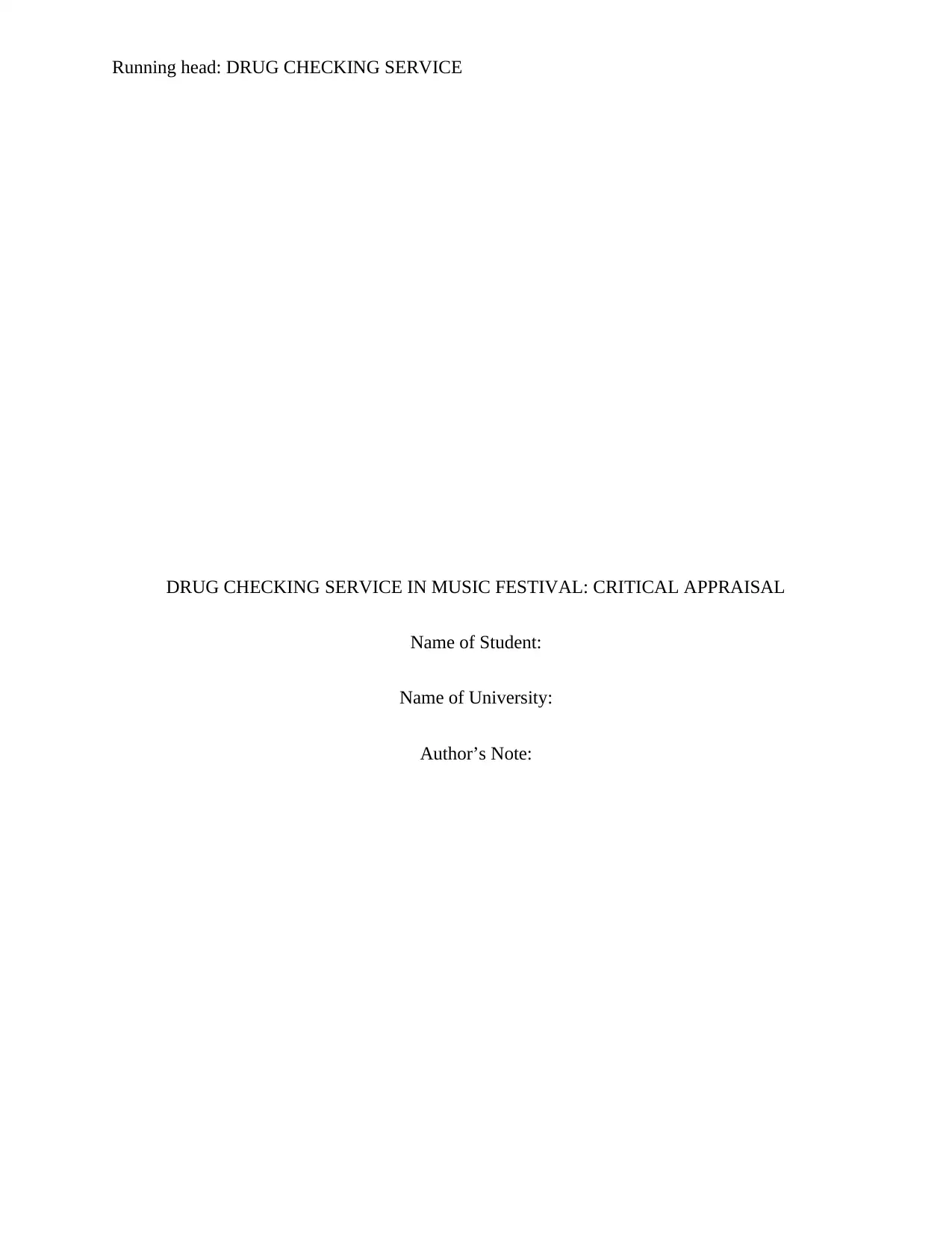
Running head: DRUG CHECKING SERVICE
DRUG CHECKING SERVICE IN MUSIC FESTIVAL: CRITICAL APPRAISAL
Name of Student:
Name of University:
Author’s Note:
DRUG CHECKING SERVICE IN MUSIC FESTIVAL: CRITICAL APPRAISAL
Name of Student:
Name of University:
Author’s Note:
Paraphrase This Document
Need a fresh take? Get an instant paraphrase of this document with our AI Paraphraser
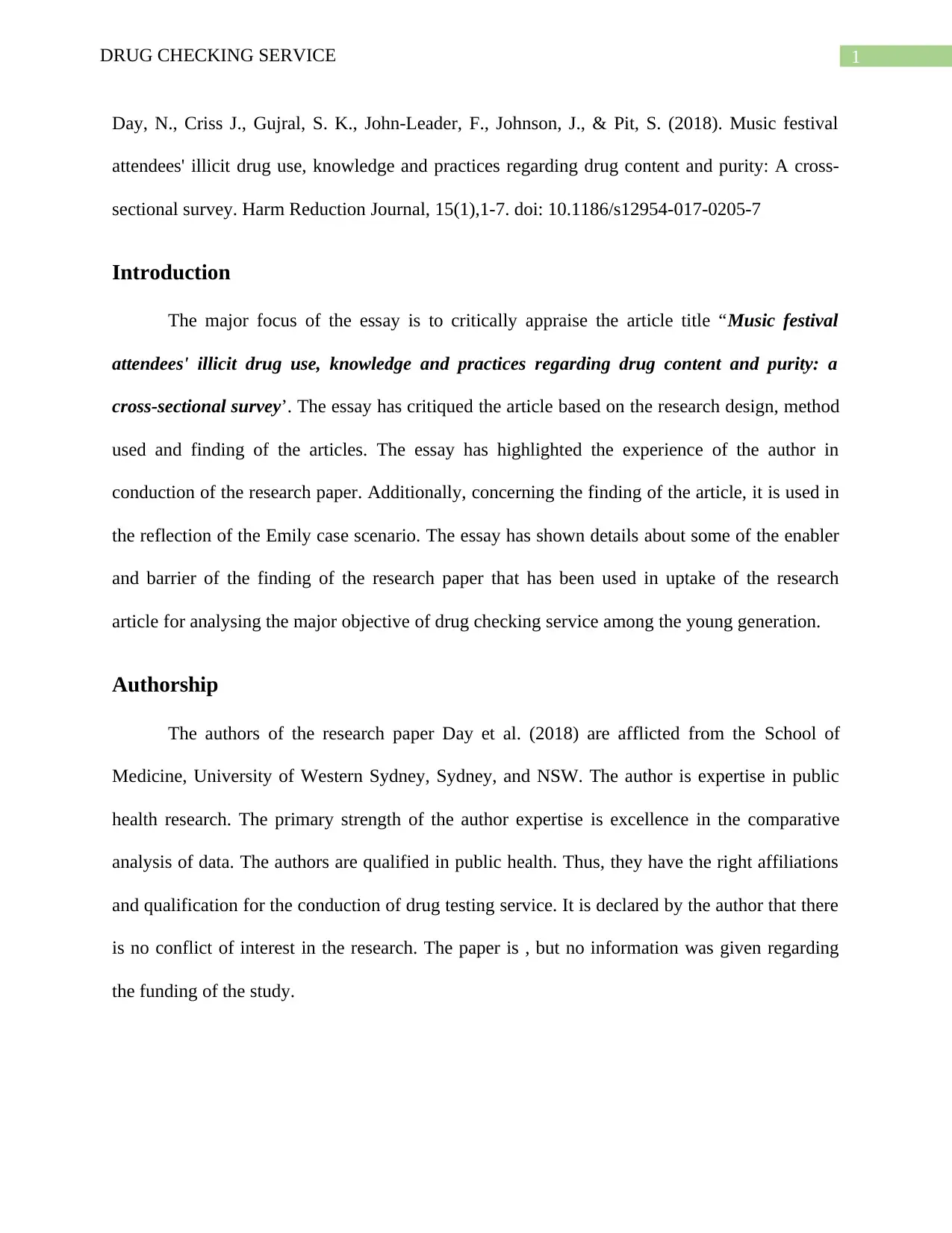
1DRUG CHECKING SERVICE
Day, N., Criss J., Gujral, S. K., John-Leader, F., Johnson, J., & Pit, S. (2018). Music festival
attendees' illicit drug use, knowledge and practices regarding drug content and purity: A cross-
sectional survey. Harm Reduction Journal, 15(1),1-7. doi: 10.1186/s12954-017-0205-7
Introduction
The major focus of the essay is to critically appraise the article title “Music festival
attendees' illicit drug use, knowledge and practices regarding drug content and purity: a
cross-sectional survey’. The essay has critiqued the article based on the research design, method
used and finding of the articles. The essay has highlighted the experience of the author in
conduction of the research paper. Additionally, concerning the finding of the article, it is used in
the reflection of the Emily case scenario. The essay has shown details about some of the enabler
and barrier of the finding of the research paper that has been used in uptake of the research
article for analysing the major objective of drug checking service among the young generation.
Authorship
The authors of the research paper Day et al. (2018) are afflicted from the School of
Medicine, University of Western Sydney, Sydney, and NSW. The author is expertise in public
health research. The primary strength of the author expertise is excellence in the comparative
analysis of data. The authors are qualified in public health. Thus, they have the right affiliations
and qualification for the conduction of drug testing service. It is declared by the author that there
is no conflict of interest in the research. The paper is , but no information was given regarding
the funding of the study.
Day, N., Criss J., Gujral, S. K., John-Leader, F., Johnson, J., & Pit, S. (2018). Music festival
attendees' illicit drug use, knowledge and practices regarding drug content and purity: A cross-
sectional survey. Harm Reduction Journal, 15(1),1-7. doi: 10.1186/s12954-017-0205-7
Introduction
The major focus of the essay is to critically appraise the article title “Music festival
attendees' illicit drug use, knowledge and practices regarding drug content and purity: a
cross-sectional survey’. The essay has critiqued the article based on the research design, method
used and finding of the articles. The essay has highlighted the experience of the author in
conduction of the research paper. Additionally, concerning the finding of the article, it is used in
the reflection of the Emily case scenario. The essay has shown details about some of the enabler
and barrier of the finding of the research paper that has been used in uptake of the research
article for analysing the major objective of drug checking service among the young generation.
Authorship
The authors of the research paper Day et al. (2018) are afflicted from the School of
Medicine, University of Western Sydney, Sydney, and NSW. The author is expertise in public
health research. The primary strength of the author expertise is excellence in the comparative
analysis of data. The authors are qualified in public health. Thus, they have the right affiliations
and qualification for the conduction of drug testing service. It is declared by the author that there
is no conflict of interest in the research. The paper is , but no information was given regarding
the funding of the study.
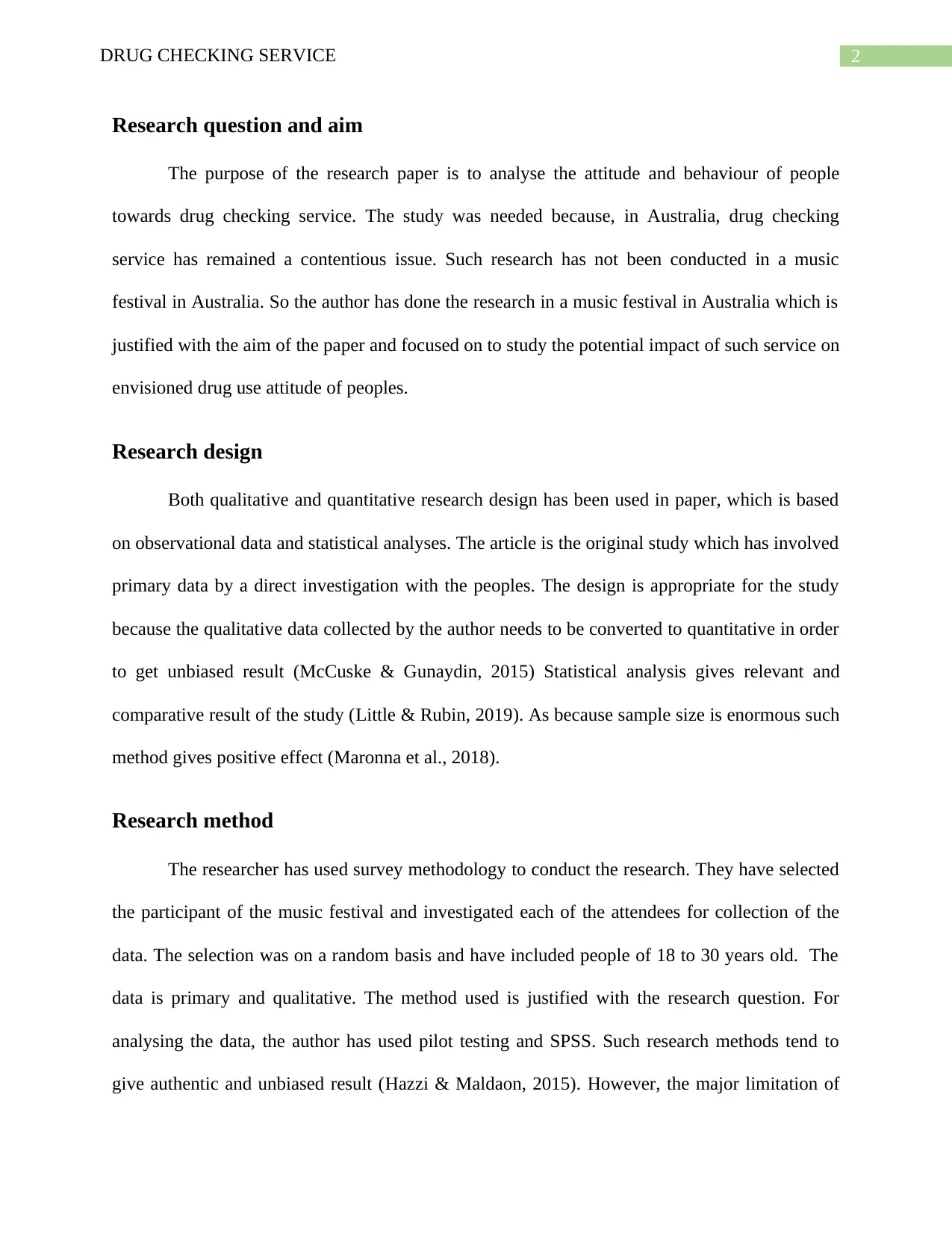
2DRUG CHECKING SERVICE
Research question and aim
The purpose of the research paper is to analyse the attitude and behaviour of people
towards drug checking service. The study was needed because, in Australia, drug checking
service has remained a contentious issue. Such research has not been conducted in a music
festival in Australia. So the author has done the research in a music festival in Australia which is
justified with the aim of the paper and focused on to study the potential impact of such service on
envisioned drug use attitude of peoples.
Research design
Both qualitative and quantitative research design has been used in paper, which is based
on observational data and statistical analyses. The article is the original study which has involved
primary data by a direct investigation with the peoples. The design is appropriate for the study
because the qualitative data collected by the author needs to be converted to quantitative in order
to get unbiased result (McCuske & Gunaydin, 2015) Statistical analysis gives relevant and
comparative result of the study (Little & Rubin, 2019). As because sample size is enormous such
method gives positive effect (Maronna et al., 2018).
Research method
The researcher has used survey methodology to conduct the research. They have selected
the participant of the music festival and investigated each of the attendees for collection of the
data. The selection was on a random basis and have included people of 18 to 30 years old. The
data is primary and qualitative. The method used is justified with the research question. For
analysing the data, the author has used pilot testing and SPSS. Such research methods tend to
give authentic and unbiased result (Hazzi & Maldaon, 2015). However, the major limitation of
Research question and aim
The purpose of the research paper is to analyse the attitude and behaviour of people
towards drug checking service. The study was needed because, in Australia, drug checking
service has remained a contentious issue. Such research has not been conducted in a music
festival in Australia. So the author has done the research in a music festival in Australia which is
justified with the aim of the paper and focused on to study the potential impact of such service on
envisioned drug use attitude of peoples.
Research design
Both qualitative and quantitative research design has been used in paper, which is based
on observational data and statistical analyses. The article is the original study which has involved
primary data by a direct investigation with the peoples. The design is appropriate for the study
because the qualitative data collected by the author needs to be converted to quantitative in order
to get unbiased result (McCuske & Gunaydin, 2015) Statistical analysis gives relevant and
comparative result of the study (Little & Rubin, 2019). As because sample size is enormous such
method gives positive effect (Maronna et al., 2018).
Research method
The researcher has used survey methodology to conduct the research. They have selected
the participant of the music festival and investigated each of the attendees for collection of the
data. The selection was on a random basis and have included people of 18 to 30 years old. The
data is primary and qualitative. The method used is justified with the research question. For
analysing the data, the author has used pilot testing and SPSS. Such research methods tend to
give authentic and unbiased result (Hazzi & Maldaon, 2015). However, the major limitation of
⊘ This is a preview!⊘
Do you want full access?
Subscribe today to unlock all pages.

Trusted by 1+ million students worldwide
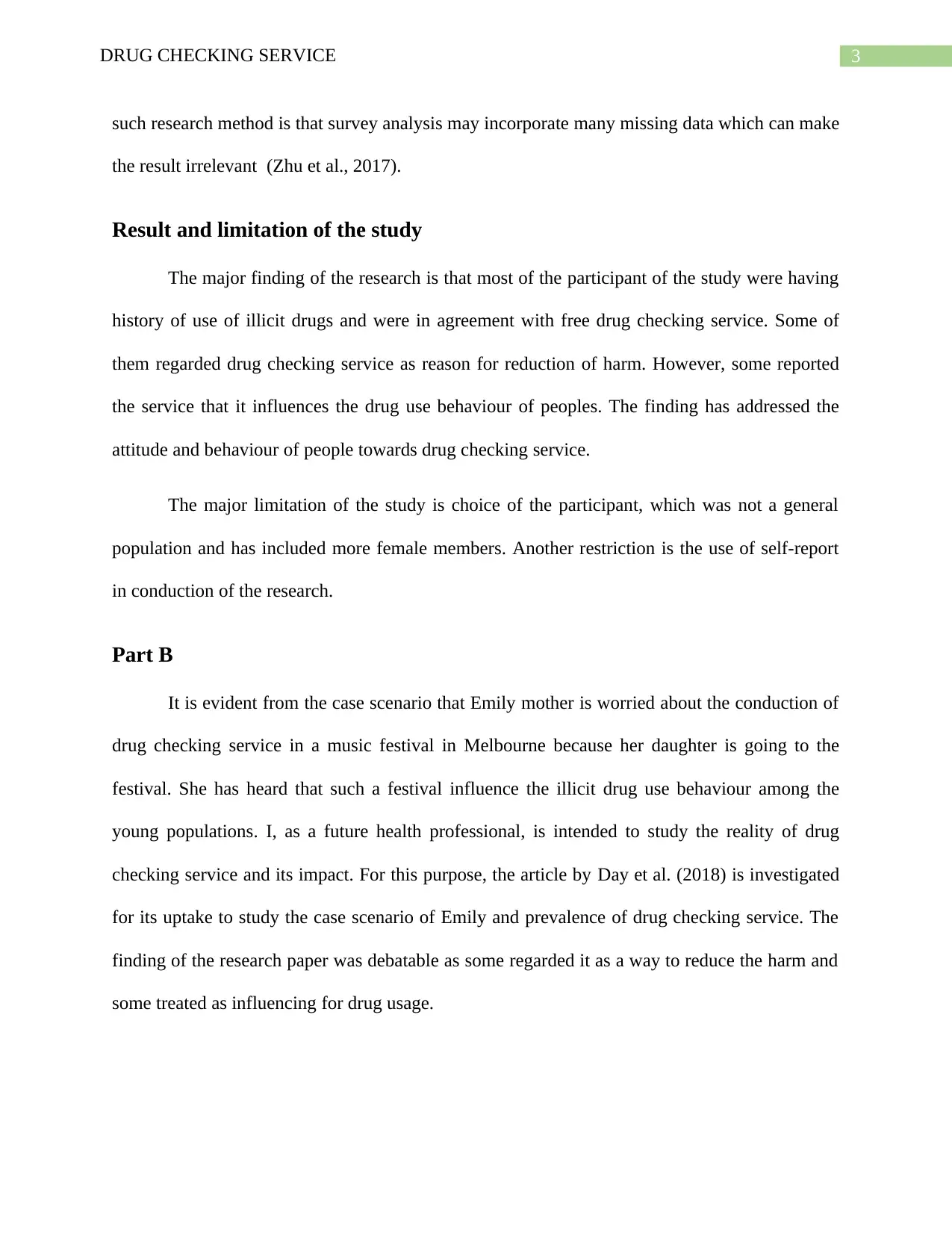
3DRUG CHECKING SERVICE
such research method is that survey analysis may incorporate many missing data which can make
the result irrelevant (Zhu et al., 2017).
Result and limitation of the study
The major finding of the research is that most of the participant of the study were having
history of use of illicit drugs and were in agreement with free drug checking service. Some of
them regarded drug checking service as reason for reduction of harm. However, some reported
the service that it influences the drug use behaviour of peoples. The finding has addressed the
attitude and behaviour of people towards drug checking service.
The major limitation of the study is choice of the participant, which was not a general
population and has included more female members. Another restriction is the use of self-report
in conduction of the research.
Part B
It is evident from the case scenario that Emily mother is worried about the conduction of
drug checking service in a music festival in Melbourne because her daughter is going to the
festival. She has heard that such a festival influence the illicit drug use behaviour among the
young populations. I, as a future health professional, is intended to study the reality of drug
checking service and its impact. For this purpose, the article by Day et al. (2018) is investigated
for its uptake to study the case scenario of Emily and prevalence of drug checking service. The
finding of the research paper was debatable as some regarded it as a way to reduce the harm and
some treated as influencing for drug usage.
such research method is that survey analysis may incorporate many missing data which can make
the result irrelevant (Zhu et al., 2017).
Result and limitation of the study
The major finding of the research is that most of the participant of the study were having
history of use of illicit drugs and were in agreement with free drug checking service. Some of
them regarded drug checking service as reason for reduction of harm. However, some reported
the service that it influences the drug use behaviour of peoples. The finding has addressed the
attitude and behaviour of people towards drug checking service.
The major limitation of the study is choice of the participant, which was not a general
population and has included more female members. Another restriction is the use of self-report
in conduction of the research.
Part B
It is evident from the case scenario that Emily mother is worried about the conduction of
drug checking service in a music festival in Melbourne because her daughter is going to the
festival. She has heard that such a festival influence the illicit drug use behaviour among the
young populations. I, as a future health professional, is intended to study the reality of drug
checking service and its impact. For this purpose, the article by Day et al. (2018) is investigated
for its uptake to study the case scenario of Emily and prevalence of drug checking service. The
finding of the research paper was debatable as some regarded it as a way to reduce the harm and
some treated as influencing for drug usage.
Paraphrase This Document
Need a fresh take? Get an instant paraphrase of this document with our AI Paraphraser
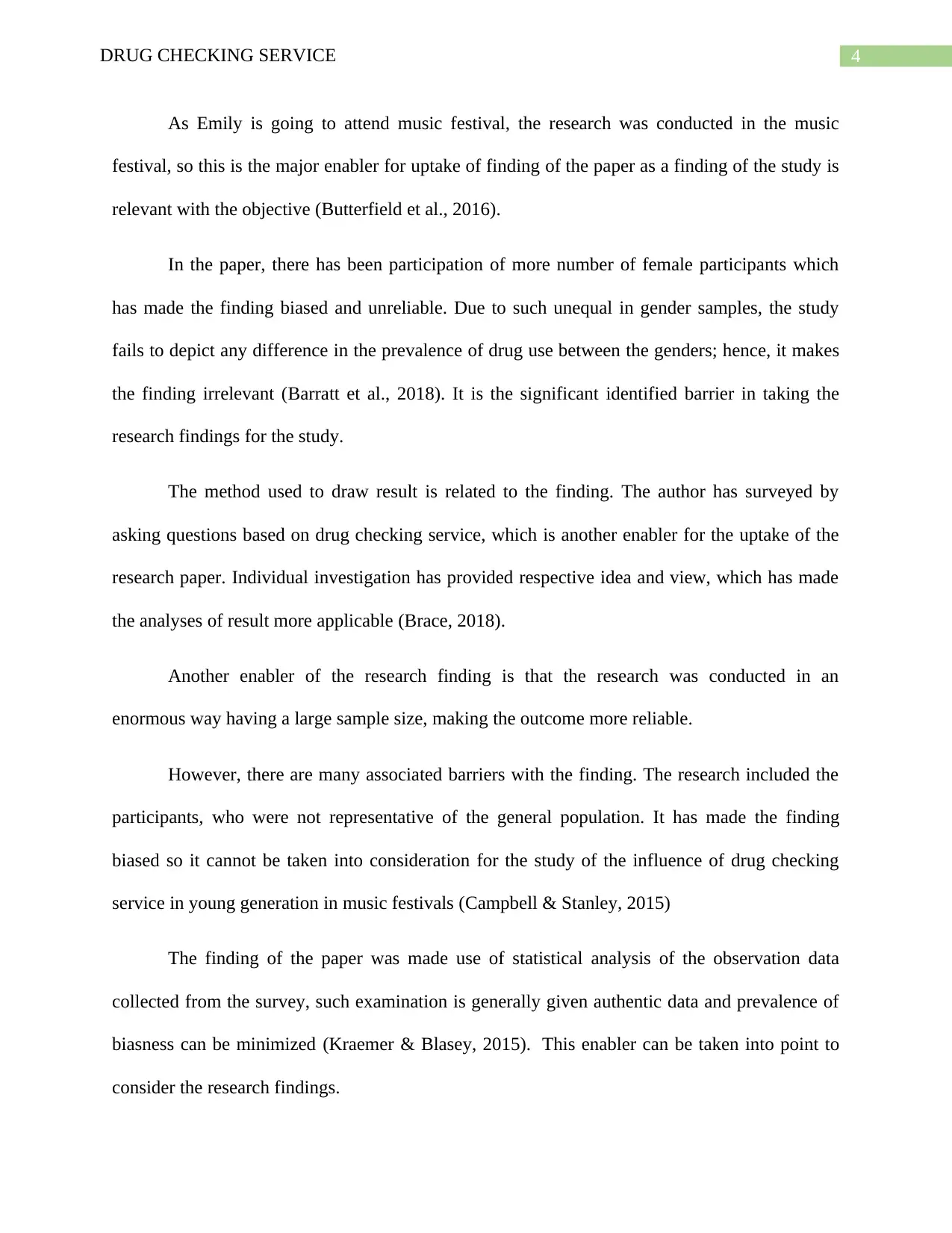
4DRUG CHECKING SERVICE
As Emily is going to attend music festival, the research was conducted in the music
festival, so this is the major enabler for uptake of finding of the paper as a finding of the study is
relevant with the objective (Butterfield et al., 2016).
In the paper, there has been participation of more number of female participants which
has made the finding biased and unreliable. Due to such unequal in gender samples, the study
fails to depict any difference in the prevalence of drug use between the genders; hence, it makes
the finding irrelevant (Barratt et al., 2018). It is the significant identified barrier in taking the
research findings for the study.
The method used to draw result is related to the finding. The author has surveyed by
asking questions based on drug checking service, which is another enabler for the uptake of the
research paper. Individual investigation has provided respective idea and view, which has made
the analyses of result more applicable (Brace, 2018).
Another enabler of the research finding is that the research was conducted in an
enormous way having a large sample size, making the outcome more reliable.
However, there are many associated barriers with the finding. The research included the
participants, who were not representative of the general population. It has made the finding
biased so it cannot be taken into consideration for the study of the influence of drug checking
service in young generation in music festivals (Campbell & Stanley, 2015)
The finding of the paper was made use of statistical analysis of the observation data
collected from the survey, such examination is generally given authentic data and prevalence of
biasness can be minimized (Kraemer & Blasey, 2015). This enabler can be taken into point to
consider the research findings.
As Emily is going to attend music festival, the research was conducted in the music
festival, so this is the major enabler for uptake of finding of the paper as a finding of the study is
relevant with the objective (Butterfield et al., 2016).
In the paper, there has been participation of more number of female participants which
has made the finding biased and unreliable. Due to such unequal in gender samples, the study
fails to depict any difference in the prevalence of drug use between the genders; hence, it makes
the finding irrelevant (Barratt et al., 2018). It is the significant identified barrier in taking the
research findings for the study.
The method used to draw result is related to the finding. The author has surveyed by
asking questions based on drug checking service, which is another enabler for the uptake of the
research paper. Individual investigation has provided respective idea and view, which has made
the analyses of result more applicable (Brace, 2018).
Another enabler of the research finding is that the research was conducted in an
enormous way having a large sample size, making the outcome more reliable.
However, there are many associated barriers with the finding. The research included the
participants, who were not representative of the general population. It has made the finding
biased so it cannot be taken into consideration for the study of the influence of drug checking
service in young generation in music festivals (Campbell & Stanley, 2015)
The finding of the paper was made use of statistical analysis of the observation data
collected from the survey, such examination is generally given authentic data and prevalence of
biasness can be minimized (Kraemer & Blasey, 2015). This enabler can be taken into point to
consider the research findings.
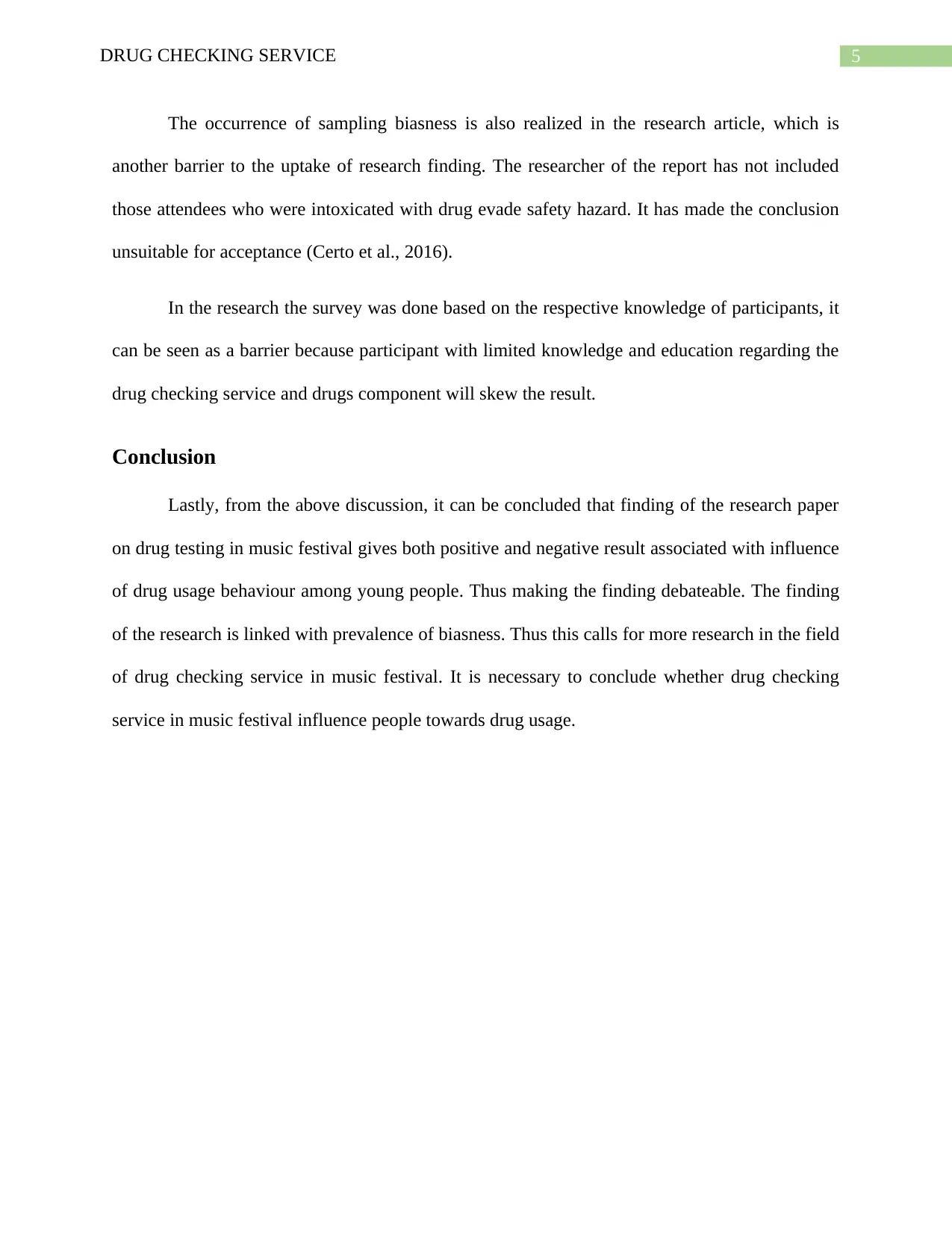
5DRUG CHECKING SERVICE
The occurrence of sampling biasness is also realized in the research article, which is
another barrier to the uptake of research finding. The researcher of the report has not included
those attendees who were intoxicated with drug evade safety hazard. It has made the conclusion
unsuitable for acceptance (Certo et al., 2016).
In the research the survey was done based on the respective knowledge of participants, it
can be seen as a barrier because participant with limited knowledge and education regarding the
drug checking service and drugs component will skew the result.
Conclusion
Lastly, from the above discussion, it can be concluded that finding of the research paper
on drug testing in music festival gives both positive and negative result associated with influence
of drug usage behaviour among young people. Thus making the finding debateable. The finding
of the research is linked with prevalence of biasness. Thus this calls for more research in the field
of drug checking service in music festival. It is necessary to conclude whether drug checking
service in music festival influence people towards drug usage.
The occurrence of sampling biasness is also realized in the research article, which is
another barrier to the uptake of research finding. The researcher of the report has not included
those attendees who were intoxicated with drug evade safety hazard. It has made the conclusion
unsuitable for acceptance (Certo et al., 2016).
In the research the survey was done based on the respective knowledge of participants, it
can be seen as a barrier because participant with limited knowledge and education regarding the
drug checking service and drugs component will skew the result.
Conclusion
Lastly, from the above discussion, it can be concluded that finding of the research paper
on drug testing in music festival gives both positive and negative result associated with influence
of drug usage behaviour among young people. Thus making the finding debateable. The finding
of the research is linked with prevalence of biasness. Thus this calls for more research in the field
of drug checking service in music festival. It is necessary to conclude whether drug checking
service in music festival influence people towards drug usage.
⊘ This is a preview!⊘
Do you want full access?
Subscribe today to unlock all pages.

Trusted by 1+ million students worldwide
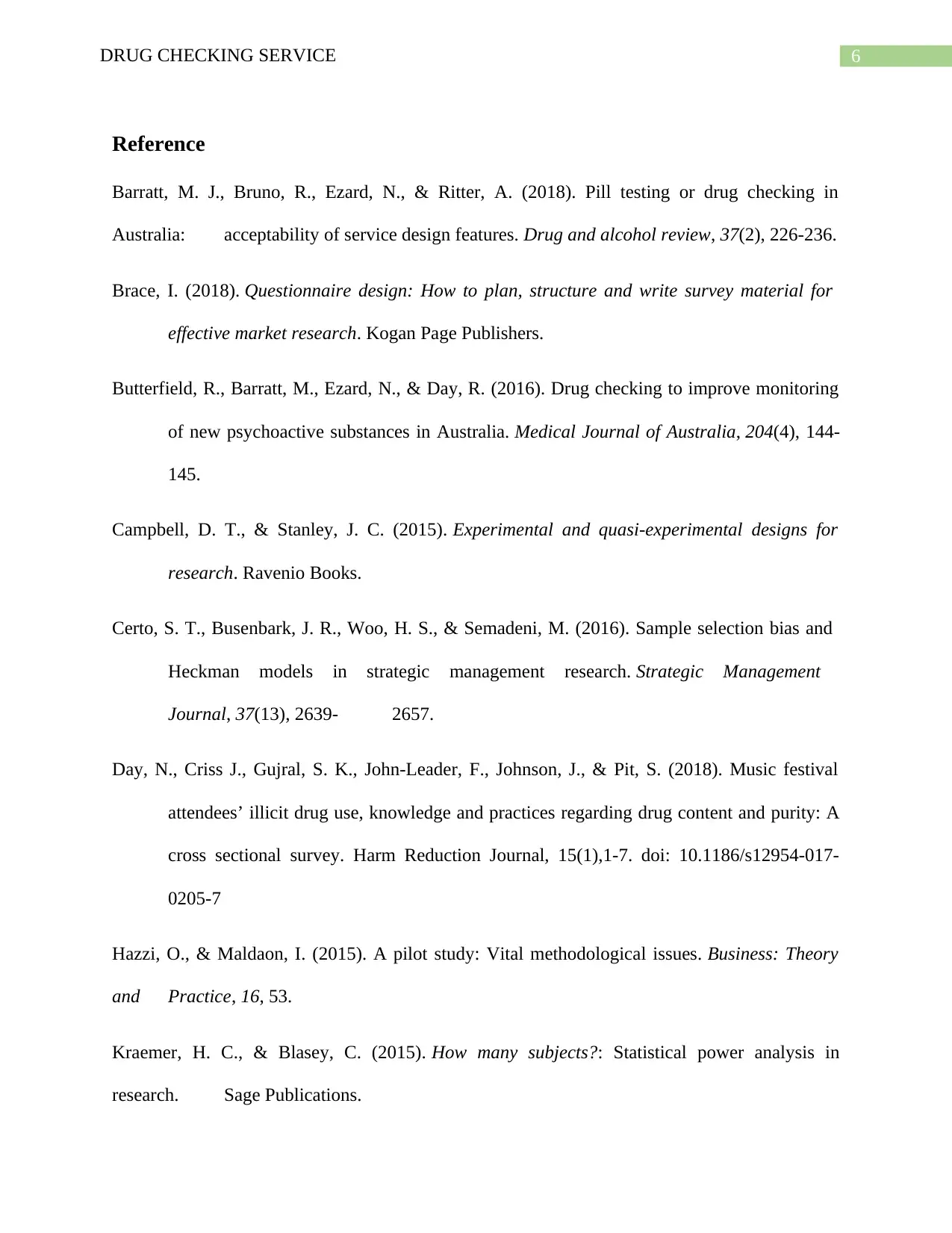
6DRUG CHECKING SERVICE
Reference
Barratt, M. J., Bruno, R., Ezard, N., & Ritter, A. (2018). Pill testing or drug checking in
Australia: acceptability of service design features. Drug and alcohol review, 37(2), 226-236.
Brace, I. (2018). Questionnaire design: How to plan, structure and write survey material for
effective market research. Kogan Page Publishers.
Butterfield, R., Barratt, M., Ezard, N., & Day, R. (2016). Drug checking to improve monitoring
of new psychoactive substances in Australia. Medical Journal of Australia, 204(4), 144-
145.
Campbell, D. T., & Stanley, J. C. (2015). Experimental and quasi-experimental designs for
research. Ravenio Books.
Certo, S. T., Busenbark, J. R., Woo, H. S., & Semadeni, M. (2016). Sample selection bias and
Heckman models in strategic management research. Strategic Management
Journal, 37(13), 2639- 2657.
Day, N., Criss J., Gujral, S. K., John-Leader, F., Johnson, J., & Pit, S. (2018). Music festival
attendees’ illicit drug use, knowledge and practices regarding drug content and purity: A
cross sectional survey. Harm Reduction Journal, 15(1),1-7. doi: 10.1186/s12954-017-
0205-7
Hazzi, O., & Maldaon, I. (2015). A pilot study: Vital methodological issues. Business: Theory
and Practice, 16, 53.
Kraemer, H. C., & Blasey, C. (2015). How many subjects?: Statistical power analysis in
research. Sage Publications.
Reference
Barratt, M. J., Bruno, R., Ezard, N., & Ritter, A. (2018). Pill testing or drug checking in
Australia: acceptability of service design features. Drug and alcohol review, 37(2), 226-236.
Brace, I. (2018). Questionnaire design: How to plan, structure and write survey material for
effective market research. Kogan Page Publishers.
Butterfield, R., Barratt, M., Ezard, N., & Day, R. (2016). Drug checking to improve monitoring
of new psychoactive substances in Australia. Medical Journal of Australia, 204(4), 144-
145.
Campbell, D. T., & Stanley, J. C. (2015). Experimental and quasi-experimental designs for
research. Ravenio Books.
Certo, S. T., Busenbark, J. R., Woo, H. S., & Semadeni, M. (2016). Sample selection bias and
Heckman models in strategic management research. Strategic Management
Journal, 37(13), 2639- 2657.
Day, N., Criss J., Gujral, S. K., John-Leader, F., Johnson, J., & Pit, S. (2018). Music festival
attendees’ illicit drug use, knowledge and practices regarding drug content and purity: A
cross sectional survey. Harm Reduction Journal, 15(1),1-7. doi: 10.1186/s12954-017-
0205-7
Hazzi, O., & Maldaon, I. (2015). A pilot study: Vital methodological issues. Business: Theory
and Practice, 16, 53.
Kraemer, H. C., & Blasey, C. (2015). How many subjects?: Statistical power analysis in
research. Sage Publications.
Paraphrase This Document
Need a fresh take? Get an instant paraphrase of this document with our AI Paraphraser
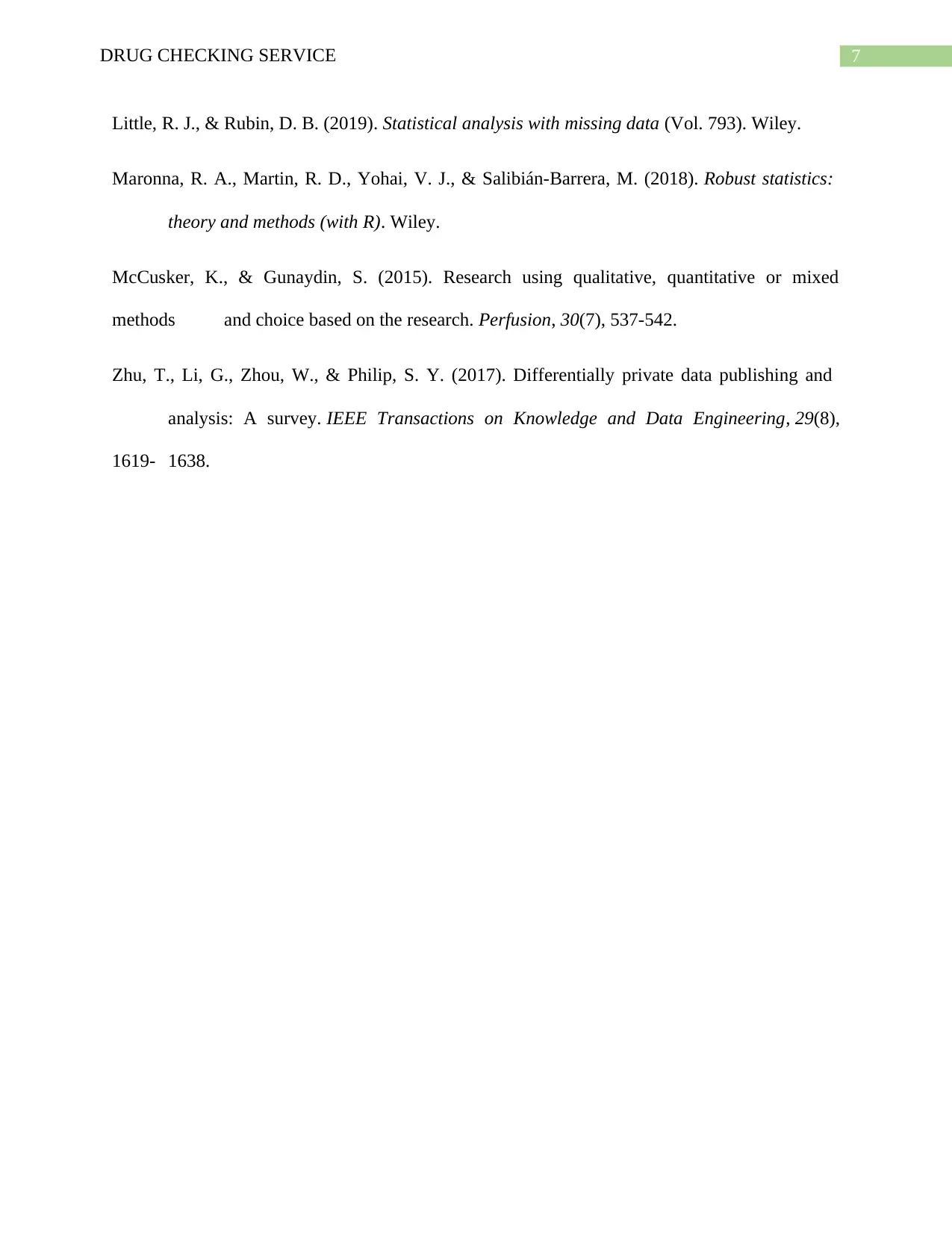
7DRUG CHECKING SERVICE
Little, R. J., & Rubin, D. B. (2019). Statistical analysis with missing data (Vol. 793). Wiley.
Maronna, R. A., Martin, R. D., Yohai, V. J., & Salibián-Barrera, M. (2018). Robust statistics:
theory and methods (with R). Wiley.
McCusker, K., & Gunaydin, S. (2015). Research using qualitative, quantitative or mixed
methods and choice based on the research. Perfusion, 30(7), 537-542.
Zhu, T., Li, G., Zhou, W., & Philip, S. Y. (2017). Differentially private data publishing and
analysis: A survey. IEEE Transactions on Knowledge and Data Engineering, 29(8),
1619- 1638.
Little, R. J., & Rubin, D. B. (2019). Statistical analysis with missing data (Vol. 793). Wiley.
Maronna, R. A., Martin, R. D., Yohai, V. J., & Salibián-Barrera, M. (2018). Robust statistics:
theory and methods (with R). Wiley.
McCusker, K., & Gunaydin, S. (2015). Research using qualitative, quantitative or mixed
methods and choice based on the research. Perfusion, 30(7), 537-542.
Zhu, T., Li, G., Zhou, W., & Philip, S. Y. (2017). Differentially private data publishing and
analysis: A survey. IEEE Transactions on Knowledge and Data Engineering, 29(8),
1619- 1638.
1 out of 8
Related Documents
Your All-in-One AI-Powered Toolkit for Academic Success.
+13062052269
info@desklib.com
Available 24*7 on WhatsApp / Email
![[object Object]](/_next/static/media/star-bottom.7253800d.svg)
Unlock your academic potential
Copyright © 2020–2025 A2Z Services. All Rights Reserved. Developed and managed by ZUCOL.





